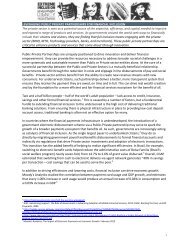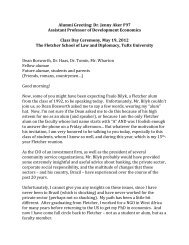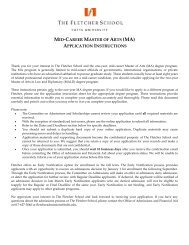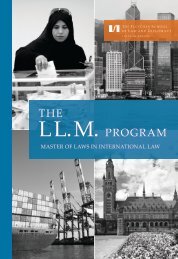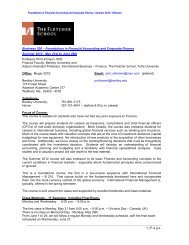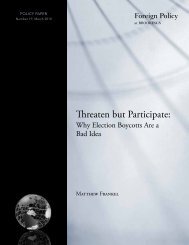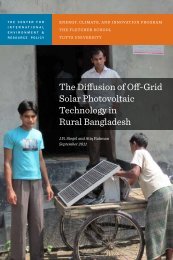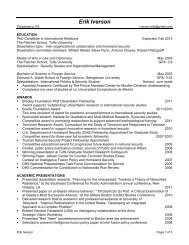A Case Study Analysis - Fletcher School of Law and Diplomacy
A Case Study Analysis - Fletcher School of Law and Diplomacy
A Case Study Analysis - Fletcher School of Law and Diplomacy
You also want an ePaper? Increase the reach of your titles
YUMPU automatically turns print PDFs into web optimized ePapers that Google loves.
The Sovereign Wealth Fund InitiativeSpring 2013The Geographic Challenges <strong>of</strong> Establishing Sovereign Wealth Funds inFrontier Markets: A <strong>Case</strong> <strong>Study</strong> <strong>Analysis</strong>By Adam B. Robbins 1IntroductionSovereign wealth funds (SWFs) face numerous, complex challenges in their establishment <strong>and</strong> growth.Like any investor, they seek investment returns in financial markets. SWFs face additional challengesstemming from their sovereign ownership: as state owned entities, they are embedded in the politicaleconomies <strong>of</strong> their host countries, <strong>and</strong> must navigate their complexities. Further complicating the matteris the location <strong>of</strong> many new SWFs. Over the past decade, SWFs have proliferated in frontier markets, farfrom the centers <strong>of</strong> global finance, adding a series <strong>of</strong> geographic challenges. Examining the development<strong>of</strong> SWFs in Mongolia <strong>and</strong> Trinidad <strong>and</strong> Tobago, this paper examines how policymakers in frontiermarkets learn to build effective SWFs, despite the geographic, political, <strong>and</strong> knowledge managementchallenges they face.The first section presents a brief overview <strong>of</strong> the policy objectives <strong>of</strong> SWFs, <strong>and</strong> the impetuses behindtheir creation. The section explores the resources that are available to policymakers in states creating newsovereign funds, as well as what resources are needed. This paper asserts that high-level advisory onmacroeconomic policy issues is readily available <strong>and</strong> transferable, while training on ground-level,intrinsic implementation skills is also available but not easily applied in frontier markets. The section1 Adam B. Robbins is a Master <strong>of</strong> International Business C<strong>and</strong>idate at The <strong>Fletcher</strong> <strong>School</strong>
2explores why implementation skills are particularly important in the investment management industry,<strong>and</strong> how the geographical contexts <strong>of</strong> new SWFs reinforce this challenge.The second section examines the development <strong>of</strong> SWFs in Mongolia <strong>and</strong> Trinidad <strong>and</strong> Tobago as casestudies, based on research interviews. This section analyzes the development <strong>of</strong> SWFs in these countries,<strong>and</strong> applies the theoretical explorations <strong>of</strong> section one to these experiences. In the case <strong>of</strong> Mongolia, theMongolian government underst<strong>and</strong>s SWF policy principles, but faces domestic political concerns <strong>and</strong>resource constraints that inhibit the establishment <strong>of</strong> an SWF conforming to these principles. In the case<strong>of</strong> Trinidad <strong>and</strong> Tobago, policymakers have also faced resource constraints, but have found methods tocope with the lack <strong>of</strong> funding <strong>and</strong> expertise. Future iterations <strong>of</strong> the paper aim to draw upon theexperience <strong>of</strong> additional frontier SWFs, to allow for a more comprehensive comparative analysis <strong>of</strong>common challenges, <strong>and</strong> how policymakers have successfully addressed them.Drawing from the exploration <strong>of</strong> the geography <strong>of</strong> finance in the first section, <strong>and</strong> the frontier SWF casestudies in the second, the third <strong>and</strong> final section <strong>of</strong> this paper suggests potential methods to mitigate thegeographic <strong>and</strong> knowledge management challenges faced by new SWFs in frontier markets.ChallengesThis first section explores the high-level policy objectives <strong>of</strong> SWFs, <strong>and</strong> then examines the geographicchallenges <strong>of</strong> effectively advancing these policy goals. There are a multitude <strong>of</strong> reasons for establishing aSWF. One can divide SWFs into three broad categories: reserve investment corporations, commoditystabilization <strong>and</strong> investment funds, <strong>and</strong> pension reserve funds (Monk 2010). Well established academicliterature documents the economic problems each category <strong>of</strong> funds is established to address. This paperdoes not examine the efficacy <strong>of</strong> SWFs in solving these economic problems, but merely points out thatSWFs are a widely accepted policy tool for addressing these problems. 2Furthermore, this academic literature has become accepted by policymakers at multilateral institutions,<strong>and</strong> it is now easily transferable <strong>and</strong> accessible globally. Many International Monetary Fund (IMF) <strong>and</strong>other multilateral institution working papers <strong>of</strong>ten take the form <strong>of</strong> “how-to” guides for policymakers ingovernments establishing SWFs (Das et al 2009). The recent proliferation <strong>of</strong> SWFs across six continents,2 For the economic rationale <strong>of</strong> investing excess foreign exchange reserves see Aizenman <strong>and</strong> Glick 2008. Dutchdisease, the harm to manufacturing <strong>and</strong> exports caused by natural resource exploitation, was identified by Corden<strong>and</strong> Neary (1982) <strong>and</strong> Corden (1984) , <strong>and</strong> is a major rationale for commodity revenue investment funds.Commodity revenue is also invested to maintain a country’s productive capacity (Solow 1986). Pension Reservefunds are established to help countries respond to the fiscal pressures <strong>of</strong> ageing populations by allowing for taxsmoothing<strong>and</strong> increasing national savings rates (Yermo 2008).
3<strong>and</strong> into such far-flung locales as Angola, Mongolia, <strong>and</strong> Papua New Guinea (to cite three <strong>of</strong> the newestSWFs), demonstrates this point.The motivations driving the establishment <strong>of</strong> SWFs are diverse, <strong>and</strong> respond to a variety <strong>of</strong> uniqueeconomic policy challenges, but one global commonality is that the number <strong>of</strong> SWFs globally isincreasing rapidly, <strong>and</strong> at an accelerating pace. As many SWFs have been founded in the past decade asin all years prior, <strong>and</strong> with a more diverse geographic distribution, suggesting that SWFs are seen as animportant, or even necessary, policy tool around the world. 3Policymakers within the host government make the final decision <strong>of</strong> whether to establish an SWF, <strong>and</strong>economic policy considerations are always the explicit motivation <strong>and</strong> justification for the fund. Butdomestic political considerations can be equally important, <strong>and</strong> numerous external actors also influencethe establishment <strong>of</strong> an SWF. These factors can include political pressure, technical assistance from bothmultilateral institutions <strong>and</strong> other governments, <strong>and</strong> regional dynamics. The following case studies willexplore the interplay between the economic policy objectives <strong>of</strong> the SWFs in Mongolia <strong>and</strong> Trinidad <strong>and</strong>Tobago, <strong>and</strong> how domestic political considerations <strong>and</strong> interaction with multilateral organizations hasinfluenced the funds’ progress toward achieving their goals.The global proliferation <strong>of</strong> SWFs based on the belief that SWFs can be used to address multiple, diverseeconomic policy challenges has been propegated by multilateral institutions <strong>and</strong> through bilateralassistance relationships. In the two case studies, the SWFs aim to address at least two distinct economicchallenges: commodity price volatility <strong>and</strong> intergenerational savings. Multilaterals such as theInternational Monetary Fund, World Bank, Asian Development Bank, <strong>and</strong> Inter-American DevelopmentBank utilize, at the minimum, two methods <strong>of</strong> spreading the SWF doctrine. Technical assistance teamsencourage the establishment <strong>of</strong> SWFs to address these economic challenges, <strong>and</strong> the IMF has conductedextensive research on the topic. More forcefully, the establishment <strong>of</strong> an SWF can be recommended as acomponent <strong>of</strong> assistance packages. 4SWFs can emerge as appealing policy solutions that can theoretically address numerous economicchallenges, concurrently satisfying the desires <strong>of</strong> multiple domestic <strong>and</strong> foreign stakeholders, therebysmoothing the path to implementation. However, attempting to operate the SWF so that it addresses3 Author’s calculation based on data from the SWF Institute. A chart is attached in the appendix.4 In both case studies, but especially in Mongolia, it sounded like the host governments established SWFs becausethe funds can theoretically address multiple policy challenges, satisfying all domestic <strong>and</strong> foreign stakeholders,making the SWF an easier sell. However, the devil is in the details—operating an SWF so that it address multiple(or even one) <strong>of</strong> the policy objectives became the larger challenge. Informal conversations with SWF hostgovernments in multiple countries support this point, <strong>and</strong> policymakers themselves are <strong>of</strong>ten aware <strong>of</strong> theinconsistencies <strong>of</strong> the objectives they are m<strong>and</strong>ated to achieve.
4multiple policy objectives can lead to conflicting policies, harming the SWF’s ability to effectivelyachieve any single objective.Other external pressures <strong>and</strong> issues not related to economic policy can also lead governments to establishSWFs. Monk suggests that SWFs, particularly in the Middle East, are sometimes established tolegitimize local economic activity, as the SWF represents a modern institution that creates a financial linkwith the global economy (2010). Clark <strong>and</strong> Monk posit that in the Middle East, the establishment <strong>of</strong> aSWF can be driven by a desire to emulate neighboring governments <strong>and</strong> signal to neighbors <strong>and</strong> localelites that the country has reached modernity, <strong>and</strong> has achieved a position <strong>of</strong> importance in global finance(2011). Other scholars have suggested that local elites establish SWFs to maintain their grip on economicpower, <strong>and</strong> to pacify domestic <strong>and</strong> foreign adversaries (Hatton <strong>and</strong> Pistor 2011).Clearly, there are many motivations for governments to establish SWFs, from globally accepted economicpolicy objectives, propagated by multilateral institutions, to reasons based on political considerations, toother non-economic motives. The multitude <strong>of</strong> motivations for fund establishment, <strong>and</strong> available fundingbecause <strong>of</strong> imbalanced global capital flows, has led to a dramatic rise in the number <strong>of</strong> SWFs over thepast decade, particularly in frontier markets. Once the government decides to establish a SWF, the fund’sconstruction raises numerous policy <strong>and</strong> operational challenges which new funds must learn to manage,<strong>and</strong> <strong>of</strong>ten struggle to do so. In frontier markets, funds face numerous geographic challenges relating totheir location, access to human talent, <strong>and</strong> political environments, which the following section willdiscuss.Geographic Challenges“Geographic challenges” refers to the difficulties <strong>of</strong> operating a SWF in a place where the investmentmanagement industry is undeveloped, <strong>and</strong> far from current global centers <strong>of</strong> finance. While technologyhas enabled investors to overcome many significant barriers related to the flow <strong>of</strong> information (theinternet can convey market data just as quickly to Ulaanbaatar as to New York), geography nonethelesspresents significant challenges. In particular, SWFs in frontier markets must cope with geographicchallenges related to human capital, politics <strong>and</strong> operating processes.Human capital represents the most significant challenge faced by SWFs in frontier markets. A majorconsequence <strong>of</strong> geographic isolation is a lack <strong>of</strong> highly skilled pr<strong>of</strong>essionals necessary to manage theSWF, <strong>and</strong> to invest in the global markets to achieve the fund’s policy goals. Bachher <strong>and</strong> Monk (2012)identify a series <strong>of</strong> challenges faced by sovereign investors in frontier markets, including their status aspublic agencies with lower pay scales than private competitors, <strong>and</strong> locations in places with shallow or
5non-existent financial labor pools. Additional challenges include laws prohibiting the hiring <strong>of</strong>foreigners 5 , <strong>and</strong> a lack <strong>of</strong> financial pr<strong>of</strong>essionals with knowledge <strong>of</strong> the country or region where the SWFis based.Governance, also described as “organizational coherence” or “an institution’s clarity <strong>of</strong> mission <strong>and</strong> itscapacities” (Clark <strong>and</strong> Urwin 2007), represents a second series <strong>of</strong> challenges facing SWFs in frontiermarkets. Studies suggest that poor governance, measured by a matrix <strong>of</strong> factors including boardcompetency, poor delegation or responsibilities to management, <strong>and</strong> inadequate compensation schemes,can harm pension fund returns by 100 to 300 basis points (Ambachtschher 2007). Other governancechallenges faced by pension funds include developing an investment philosophy with firm-wide support,creating a decision-making process that incorporates the institution’s comparative advantages <strong>and</strong>disadvantages, <strong>and</strong> is responsive enough react to market events in a timely fashion (Clark <strong>and</strong> Urwin2007). While literature does not exist on the effects <strong>of</strong> governance on SWF performance, the impact <strong>of</strong>poor governance on SWFs may correspond to these figures. 6 Because governance practices are <strong>of</strong>teninherited from the sponsoring institution, <strong>and</strong> many <strong>of</strong> the new SWFs are sponsored by governments withpoor governance practices (Kauffman et al. 2010), the impact <strong>of</strong> poor governance may be more evensignificant. 7The challenges <strong>of</strong> process <strong>and</strong> poor governance discussed above suggest that learning to establish <strong>and</strong>operate a SWF require both significant transfer <strong>of</strong> knowledge <strong>of</strong> economic policy <strong>and</strong> investment as wellas experience in finance <strong>and</strong> operating a complex firm. One common method <strong>of</strong> sidestepping thischallenge is outsourcing, <strong>and</strong> many SWFs (as the case <strong>of</strong> Trinidad <strong>and</strong> Tobago will demonstrate)outsource almost all <strong>of</strong> their investment activities. SWFs can outsource both investment <strong>and</strong> operationalprocesses. However, while outsourcing can directly address deficiencies in human talent <strong>and</strong> investmentprocess, challenges <strong>of</strong> governance <strong>and</strong> political interference may be more difficult to circumvent. Inparticular, outsourcing cannot prevent unexpected, politically motivated changes in contribution orwithdrawal policy. Furthermore, successful outsourcing is dependent on the SWFs ability to selectinvestment managers <strong>and</strong> other service providers, which the fund may not be equipped to do.SWF Proliferation vs. Sticky Knowledge5 Based on author’s conversation with an investment pr<strong>of</strong>essional at an SWF based in a frontier market.6 The national importance <strong>of</strong> SWFs <strong>and</strong> the intense national <strong>and</strong> international scrutiny many SWFs receive may alsoaffect their governance (both positively <strong>and</strong> negatively).7 The citation is for the World Bank governance rankings. Mongolia ranks in the 25 th -50 th percentile on mostgovernance indicators. I have not plotted the correlation between poor governance <strong>and</strong> countries with new SWFs,but expect there to be a strong overlap.
6The contrast between the rapid proliferation <strong>of</strong> SWFs in frontier markets, on the one h<strong>and</strong>, <strong>and</strong> the manychallenges that they must learn to cope with, on the other, is exacerbated by the nature <strong>of</strong> the investmentindustry. Investment is a hyper-competitive industry focused on the production <strong>of</strong> one “product”, a rate<strong>of</strong> return that is achieved through execution <strong>of</strong> investment strategies. Thus, the financial industry is oneglobally unified market aimed at capturing a completely non-differentiated product, investment return.Investment is thus based solely on execution, <strong>and</strong> the ability to innovate within the investment processitself. 8 While SWFs investment strategies diverge widely, most allocate a significant portion <strong>of</strong> theirportfolio to globally competitive financial markets. 9Clark <strong>and</strong> Monk posit that the ability to compete within the financial industry is based upon threeintangible assets: human capital, the process <strong>of</strong> decision-making, <strong>and</strong> the data <strong>and</strong> informationinfrastructure <strong>and</strong> architecture (2012). While technology has mitigated the impact <strong>of</strong> geography on accessto financial data, human capital <strong>and</strong> the process <strong>of</strong> decision making are two areas where SWFs in frontiermarkets suffer their greatest comparative disadvantages.Further increasing the difficulty <strong>of</strong> strengthening human capital <strong>and</strong> institutional processes is the nature <strong>of</strong>the knowledge involved in these aspects <strong>of</strong> the investment process. Human capital <strong>and</strong> investmentprocesses rely heavily on “tacit knowledge”, or knowledge that is best conveyed through demonstration<strong>and</strong> experience, in contrast to “codified knowledge,” knowledge that is easily verbalized or transferredthrough writing.SWFs in frontier markets face multiple impediments to learning how to resolve challenges <strong>of</strong> humancapital <strong>and</strong> process, discussed above. Coping with human capital challenges is particularly difficult. Asdiscussed above, many SWFs are unable to pay competitive salaries to attract human talent, facerestrictions on hiring foreigners, <strong>and</strong> suffer from shallow local labor pools. And even when SWFs are ableto hire employees with the requisite knowledge, sharing knowledge from an individual to the broader firmis challenging (Gertler 2003). Similarly, tacit knowledge does not travel easily between heterogeneousgroups:This is because its transmission is best shared through face-to-face interaction between partnerswho already share some basic similarities: the same language; common ‘codes’ <strong>of</strong>communication; shared conventions <strong>and</strong> norms; personal knowledge <strong>of</strong> each other based on a pasthistory <strong>of</strong> successful collaboration <strong>and</strong> informal interaction (Gertler 2003).8 This may not hold true for all financial markets, for example private equity, infrastructure, <strong>and</strong> other alternatives,but it does hold true for the highly liquid sovereign debt <strong>and</strong> global equity markets in which SWFs participate.9 It is worth noting that, unlike pension funds <strong>and</strong> commercially motivated investors, an SWF’s fulfillment <strong>of</strong> itspolicy objective may not depend on investing well or achieving a target rate <strong>of</strong> return.
7Such difficulties in spreading tacit knowledge help explain why, despite improvements in informationtechnology, the financial industry remains highly concentrated in a small number <strong>of</strong> global cities. Tacitknowledge is typically conveyed through demonstration, <strong>and</strong> reinforced through interaction, conditionswhich further stress the difficulties <strong>of</strong> investing in the global markets from a frontier market. New SWFsin frontier markets will have to find methods to overcome these knowledge barriers if they are to competesuccessfully in the global financial markets.Because institutional processes are largely based on tacit knowledge, geography further complicates thedevelopment <strong>of</strong> new SWFs in frontier markets. Innovation in financial institutions <strong>of</strong>ten depends onlearning from networks <strong>and</strong> competitors. Gertler asserts that innovation is <strong>of</strong>ten spatially sticky, sinceinnovation requires networks <strong>of</strong> multiple heterogeneous entities, including corporations, universities, <strong>and</strong>civil society (2003). These requirements for successful investment in the global markets, combined withthe increasing popularity <strong>of</strong> SWFs as economic policy tools in frontier markets, leave many new SWFswith policy m<strong>and</strong>ates they are poorly equipped to fulfill.Many SWFs have developed strategies to circumvent or overcome these geographic challenges. ManySWFs have established <strong>of</strong>fices in global financial centers, with allows them better access to human talent,<strong>and</strong> provides closer proximity to the markets <strong>and</strong> service providers. SWFs also leverage relationshipswith service providers to reduce geographic isolation by locating SWF employees at provider sites, orbring service providers to SWF locations. Such relationships provide SWFs with the tacit knowledge,<strong>and</strong> access to networks that are necessary to invest innovatively <strong>and</strong> competitively.Mongolia 10The Government <strong>of</strong> Mongolia <strong>and</strong> its SWFs serve as a case study for the discussion <strong>of</strong> the effects <strong>of</strong>geography <strong>and</strong> knowledge transfer on the establishment <strong>of</strong> SWFs in frontier markets. The MongolianDevelopment Fund was established by law in 2007, <strong>and</strong> efforts gained urgency during the 2008 financialcrisis. As the prices <strong>of</strong> Mongolia’s commodity exports crashed, Mongolia entered a fiscal crisis <strong>and</strong> wasforced to seek international assistance. The IMF provided financial assistance, <strong>and</strong> encouraged Mongoliato establish a SWF to help manage the impact <strong>of</strong> commodity price instability. At the same time, at thebehest <strong>of</strong> a World Bank funded advisor, Mongolia passed a fiscal stability law limiting fiscal deficits,similar to a Chilean law limiting fiscal deficits. It’s not completely clear how Chile became Mongolia’s10 Unless otherwise stated, quotes <strong>and</strong> facts in the Mongolia section are based on the author’s 2012 interview with awell-informed observer <strong>of</strong> the Mongolian SWF. Many <strong>of</strong> the interviewees statements can be corroborated by newsarticles, publications by multilateral institutions, <strong>and</strong> the Mongolian government’s own publications.
8model; one possibility is that Chile was a used as a model because both countries are major copperexporters.The Human Development Fund, established in 2009, replaced the Mongolian Development Fund. Itsexact origin is uncertain, but from its founding the fund has had a domestic investment focus, differentfrom either <strong>of</strong> the funds suggested by the IMF. However, shortly after the fund’s founding, it was used asa mechanism for cash distribution <strong>and</strong> untargeted social spending (Ognon 2013). Cash distribution hadthe potential to exacerbate one <strong>of</strong> the problem the fund was envisioned to address: the overheating <strong>of</strong>Mongolia’s economy. Outside observers such as the World Bank were especially critical <strong>of</strong> the fund,which served as an instrument for politicians to fulfill election promises <strong>of</strong> cash h<strong>and</strong>outs to citizens,rather than to accomplish the policy aims the IMF had initially envisioned.The law establishing the Fiscal Stability Fund, first proposed in 2008, passed in 2010, <strong>and</strong> the fund nowholds approximately $300 million, according to a recent presentation by the Mongolian Ministry <strong>of</strong>Finance (Ognon 2013). A funding formula based on a reference price <strong>of</strong> copper was suggested, but notimmediately implemented. The value <strong>of</strong> the fund is expected to begin to increase rapidly in early 2013,when production at an enormous copper <strong>and</strong> gold mine, Oyu Tolgoi, is expected to begin. Mineralroyalties account for over 30% <strong>of</strong> the government’s revenues, <strong>and</strong> will increase further once Oyu Tolgoicomes online. Based on a study conducted by the Ministry <strong>of</strong> Finance with support from the World Bank,the Central Bank will manage the fund until assets reach 10% <strong>of</strong> GDP (Ognon 2013). Funds in excess <strong>of</strong>that amount will be managed jointly by the Central Bank <strong>and</strong> Ministry <strong>of</strong> Finance for long-term financialreturn (Ognon 2013).Bureaucratic <strong>and</strong> organizational challenges have also hindered the implementation <strong>and</strong> effectiveness <strong>of</strong>the new SWFs. The long-term fund has not yet been established, <strong>and</strong> “it’s clear the Minister <strong>of</strong> Financehas not read the [World Bank consultant’s] report”, nor does there appear to be a political consensusbehind establishing the long-term fund. While some <strong>of</strong>ficials within the government are now fully aware<strong>of</strong> the fund’s potential objective <strong>and</strong> strategy, Mongolian news agency Montsame quoted the PrimeMinister supporting a policy <strong>of</strong> cash h<strong>and</strong>outs from the SWF to generate jobs <strong>and</strong> income. The CentralBank is tasked with administering the FSF, but has only a minimal capacity to do so because it lackspr<strong>of</strong>essional staff with investment management experience. Since the fund’s founding, all assets havebeen held in cash because investment processes have not yet been established.The Central Bank is a member <strong>of</strong> the World Bank’s Reserve Asset Management Program (RAMP).RAMP is an advisory <strong>and</strong> management program <strong>of</strong> the World Bank Treasury that assists <strong>of</strong>ficialinstitutions such as central banks, pension funds <strong>and</strong> commodity funds. RAMP assists members through
9designing fund rules, developing governance <strong>and</strong> strategic asset allocation capabilities, exp<strong>and</strong>ing internalmanagement capabilities, <strong>and</strong> providing information technology, legal, <strong>and</strong> communications support.RAMP also conducts on <strong>and</strong> <strong>of</strong>f site educational programs, <strong>and</strong> provides internships to members. Finally,RAMP manages over $100 billion in member assets. RAMP is open to all <strong>of</strong>ficial institutions <strong>of</strong> WorldBank member countries.It is unclear why the fund remains in cash, <strong>and</strong> has not yet been invested, given the Mongoliangovernment’s ongoing relationship with RAMP. The Mongolian Central Bank also has a strongrelationship with the People’s Bank <strong>of</strong> China, <strong>and</strong> China Daily reported that in 2012 the two countriesexp<strong>and</strong>ed their currency swap agreements, but suspicion <strong>of</strong> Chinese influence prevents them from seekingtechnical assistance from the Chinese.The situation is further confused by conflicting recommendations from technical advisors. Onemultilateral institution has supported Mongolia’s adoption <strong>of</strong> the “Chilean model” for its SWFs, whileanother advocates for a “Norwegian model”. The two models differ significantly, as the “Chilean model”is based on a rule-based fiscal policy, in which government copper revenue enters the government budget,<strong>and</strong> then surplus (deficit) is allocated to (from) the two SWFs per a fiscal policy rule. The fiscal policyrule limits surpluses <strong>and</strong> deficits, <strong>and</strong> is linked to the global price <strong>of</strong> copper. In contrast, the “Norwegianmodel” stipulates that all government oil revenue enters the SWF, <strong>and</strong> then up to 4% <strong>of</strong> the fund valuemay be allocated to the government budget to cover a budget deficit. Additionally, the Norwegian fundperforms both stabilization <strong>and</strong> savings functions, while Chile has created a separate fund for eachpurpose.The conflict in selecting between the “Chilean model” <strong>and</strong> the “Norwegian model” extends to politicaldivisions within the government as well, with the Ministry <strong>of</strong> Finance siding with the “Chilean model”,<strong>and</strong> the Presidency supporting the “Norwegian model”. Both contingents have brought in foreignconsultants to support their respective cases, who are typically former government <strong>of</strong>ficials from therespective countries.The interviewee considered the biggest impediment to operating the fund to be lack <strong>of</strong> human capital. “Ithink it’s lack <strong>of</strong> expertise. They’re out here in the middle <strong>of</strong> the steppe <strong>and</strong> they’ve never done it before.They just don’t have the in-house expertise to h<strong>and</strong>le it mechanically.”The interviewee stated that this lack <strong>of</strong> human capital is largely caused by Mongolia’s geography <strong>and</strong>isolation from the world. As a percentage <strong>of</strong> the population, the Mongolian diaspora is very small.
10Despite a literacy rate <strong>of</strong> 97%, <strong>and</strong> an effective post-secondary educational system, the Mongolianworkforce lacks real world business experience, <strong>and</strong> a lack <strong>of</strong> integration into global financial networks:They think because they have an economics degree that they have a great underst<strong>and</strong>ing <strong>of</strong> howthe economy should function <strong>and</strong> have a great level <strong>of</strong> financial expertise, but it’s not reallyinformed by the kind <strong>of</strong> real world experience that you might see in another country, whereyou’ve got people coming back from overseas…there are no foreign banks here operating, it’s alllocal banks…no investment banks have <strong>of</strong>fices here, no foreign insurance companies, so it’s hardfor people here locally to learn when you don’t have that kind <strong>of</strong> base to learn from.The shortcomings <strong>of</strong> the Mongolian labor force demonstrate the lack <strong>of</strong> experience, or tacit knowledge,necessary to operate a complex institution in the financial sector.Despite this lack <strong>of</strong> resources, the interviewee believes that the most senior leadership <strong>of</strong> the Mongoliangovernment has the skills to secure the expertise <strong>and</strong> establish the fund. However, as Mongolia is ayoung <strong>and</strong> turbulent democracy, there is little political incentive to do so. Much to the chagrin <strong>of</strong>multilateral institutions, Mongolia’s first SWF, the Human Development Fund, was used for cashh<strong>and</strong>outs to citizens rather than long-term investment. This was not the result <strong>of</strong> a lack <strong>of</strong> know-how,rather, it was necessitated by the desire to stay in <strong>of</strong>fice, <strong>and</strong> secure votes. These cash h<strong>and</strong>outscontributed to the economy’s overheating (Ognon 2013), an ironic phenomenon given that many SWFsare created to prevent this phenomenon.The economic challenges the Government <strong>of</strong> Mongolia faces, commodity price instability, the need toavoid “Dutch Disease”, economic overheating, <strong>and</strong> desire to save natural resource wealth for futuregenerations, could all be addressed via the establishment <strong>of</strong> SWFs. And while Mongolia has beenadvised <strong>and</strong> intends to do this, significant geographic hurdles, including a lack <strong>of</strong> human capital, <strong>and</strong>domestic political challenges have thus far prevented SWFs from being implemented effectively.Trinidad <strong>and</strong> Tobago 11Trinidad <strong>and</strong> Tobago’s Heritage <strong>and</strong> Stabilization Fund (HSF) has faced geographic challenges similar tothose encountered in Mongolia. However, the development <strong>of</strong> the HSF demonstrates how smaller SWFsin frontier markets can effectively overcome these challenges. Trinidad <strong>and</strong> Tobago’s SWF began asinterim fund in 2000, <strong>and</strong> was formally launched as the HSF in 2007.11 Unless otherwise stated, quotes <strong>and</strong> facts in this section are sourced from a 2012 interview with Gov. EwartWilliams conducted by the <strong>Fletcher</strong> <strong>School</strong>’s Sovereign Wealth Fund Initiative. A full citation appears in thebibliography.
11Trinidad <strong>and</strong> Tobago is an oil exporting country, <strong>and</strong> experienced the boom <strong>and</strong> bust cycle in the 1970s<strong>and</strong> 1980s. Following this cycle, external debt increased, <strong>and</strong> the country endured a World Bankadministered structural adjustment program. Having learned from this experience, the government savedexcess oil revenues in the early 2000s, <strong>and</strong> began to develop the HSF, which was formally launched in2007.Norway’s Government Pension Fund Global (GPFG) served as the model for the HSF. The GPFP modelfor both governance <strong>and</strong> transparency was directly replicated, but the investment strategy was modifiedbecause, while the Norwegian fund’s investment strategy is now focused on a savings objective, the HSFhas both stabilization <strong>and</strong> long-term savings objectives.Like GPFG, the management <strong>of</strong> the HSF is outsourced to the central bank. However, while Norwaymanages much <strong>of</strong> its SWF internally through an independent unit <strong>of</strong> its central bank, Norges BankInvestment Management, the central bank <strong>of</strong> Trinidad <strong>and</strong> Tobago outsources the management to externalmanagers. The HSF currently has a board with delegates its powers to the Central bank, but has nodedicated staff members.Trinidad <strong>and</strong> Tobago sought <strong>and</strong> received technical assistance to establish the HSF from the WorldBank’s RAMP program. Williams stated: “Because we were members, when we started to think aboutthe HSF, we sought technical assistance from the World Bank. We worked closely with them in the legaldrafting <strong>and</strong> in thinking through the strategic asset allocation.” They also worked closely with RAMP onmanager selection, <strong>and</strong> the Central Bank receives training from RAMP with the long-term objective <strong>of</strong>more directly involving Central Bank staff in the investment process (like in Norway). The relationshipbetween the central bank <strong>and</strong> RAMP has been very productive, <strong>and</strong> the HSF has functioned successfullyfor several years in cooperation with RAMP.They also aim to construct a board that fully incorporates multiple local stakeholders—business leaders,trade unions, the energy sector, <strong>and</strong> the banking sector.Underst<strong>and</strong>ing Trinidad <strong>and</strong> Tobago’s Success
12Based on the interviewee’s description, policymakers in Trinidad <strong>and</strong> Tobago have built a successful,well governed, <strong>and</strong> transparent SWF, despite the lack <strong>of</strong> dedicated staff to the HSF. 12 Several factorshave led to the HSF’s successful development.Perhaps most importantly, the impetus behind the fund arose domestically within Trinidad <strong>and</strong> Tobago.Having experienced a boom-<strong>and</strong>-bust commodity cycle, a broad consensus emerged within thegovernment supporting the establishment <strong>of</strong> the fund. While policymakers have differing views on theexact functions <strong>of</strong> the HSF, they can be met through the hybrid (both savings <strong>and</strong> stabilization) nature <strong>of</strong>the fund. In contrast, Mongolia does not have such a long history with experiencing commodity boom<strong>and</strong> bust cycles, as a constitution allowing for a market economy was introduced relatively recently, in1992. Additionally, the pressures behind the formation <strong>of</strong> an SWF in Mongolia were initially foreignrather than domestic, which hinders the formation <strong>of</strong> a domestic political consensus behind the fund, <strong>and</strong>the establishment <strong>of</strong> a specific investment m<strong>and</strong>ate.Trinidad <strong>and</strong> Tobago followed the “Norwegian model”, which has transferred well to the HSF. Oneunderlying reason for this could be that a model for accountable <strong>and</strong> transparent fund governancetransfers more easily to Trinidad <strong>and</strong> Tobago than Mongolia, given Trinidad <strong>and</strong> Tobago’s betterperformance on corruption <strong>and</strong> government effectiveness indicators (Kaufman et al 2010). Further, thedomestic consensus behind a hybrid SWF model is well met by the structure <strong>of</strong> the Norwegian model,which can be adapted to perform both stabilization <strong>and</strong> savings functions.One crucial area in which Trinidad <strong>and</strong> Tobago has succeeded is in committing to saving for the future,<strong>and</strong> resisting the temptation to spend windfall oil revenues now. This is likely a result <strong>of</strong> the country’sexperience <strong>of</strong> the 1970s <strong>and</strong> 1980s boom <strong>and</strong> bust cycle, <strong>and</strong> the painful structural adjustment it enduredfollowing this period. The experience may have giving policymakers the fortitude to withst<strong>and</strong> pressuresto spend the revenue. Trinidad <strong>and</strong> Tobago also ranks highly in government effectiveness in comparisonto Mongolia, which may also reflect the government’s ability to create an SWF oriented toward medium<strong>and</strong> long-term economic policy challenges. In the Mongolian case, in contrast, the Human DevelopmentFund was quickly raided for short-term political gain, perhaps a result <strong>of</strong> a poorly functioning politicalsystem, or limited public support for longer-term investment.The strong prior relationship between the Central Bank <strong>and</strong> RAMP was a key factor <strong>of</strong> success <strong>of</strong> theHSF. The RAMP program provided assistance with manager selection, the fund’s legal framework, <strong>and</strong>12 One problem with directly comparing the HSF <strong>and</strong> the Mongolian fund based on the interviews conducted is thediffering positions <strong>of</strong> the interviewees: a well-informed outside observer (Mongolia) vs. the policymaker who ledthe establishment <strong>of</strong> the HSF.
13trainings for Central Bank employees. The HSF is building its internal capacities, <strong>and</strong> hopes to assumeinvestment management responsibility over the long-term. This relationship may be the result <strong>of</strong> efforts<strong>of</strong> Mr. Ewart Williams, former governor <strong>of</strong> the Central Bank who served in several senior positions at theIMF. This long-time experience with the Washington multilateral institutions contrasts with theMongolian experience, which is geographically distant, <strong>and</strong> did not closely engage these institutionsuntil1992.The comparison between the cases <strong>of</strong> Mongolia <strong>and</strong> Trinidad <strong>and</strong> Tobago reveals characteristics thatcould be indicators <strong>of</strong> potential success. These include:• An organic, internal impetus for creating the SWF• Popular underst<strong>and</strong>ing <strong>and</strong> experience with the economic challenges the SWF is designed toaddress• Implementation <strong>of</strong> a model that can address all major concerns <strong>of</strong> policymakers (in Trinidad <strong>and</strong>Tobago, the ability to fulfill both the stabilization <strong>and</strong> savings objectives)• A strong familiarity with the multilateral organizations from which the host government willreceive supportTrinidad <strong>and</strong> Tobago demonstrated all <strong>of</strong> these characteristics, while Mongolia did not. Key,compounding difficulties in Mongolia were the large geographic barriers, including a lack <strong>of</strong> humantalent, poor governance, <strong>and</strong> political challenges, which were perhaps so large that they preventedeffective outsourcing. Trinidad <strong>and</strong> Tobago, on the other h<strong>and</strong>, was able to effectively contract withoutsourcing providers to overcome the relatively smaller resource <strong>and</strong> geographic constraints it faced.ConclusionThis paper explores the imbalance between the rapid proliferation <strong>of</strong> SWFs in frontier markets, which is<strong>of</strong>ten based on sound economic policy, <strong>and</strong> the geographic challenges they face, including access tohuman capital <strong>and</strong> organizational coherence, that might prevent new funds from accomplishing theirpolicy objectives. While the examination <strong>of</strong> two cases is insufficient to draw broad reaching conclusions,it nonetheless illuminates potential pitfalls <strong>and</strong> ways to address them.Outsourcing is one method <strong>of</strong> circumventing many <strong>of</strong> the challenges faced by SWFs in frontier markets.Trinidad <strong>and</strong> Tobago has been able to successfully operate the HSF completely via outsourcing. The fundwas established with outsourced technical assistance from multilateral institutions, <strong>and</strong> the current
14investment management function is outsourced to external asset managers. In contrast, Mongolia has notbeen able to use outsourcing effectively, largely because <strong>of</strong> political challenges, <strong>and</strong> also because itlacked familiarity with outside service providers, either multilateral or private sector.Developing this familiarity, <strong>and</strong> a baseline knowledge to allow outsourcing to occur, will require thedevelopment <strong>of</strong> basic competencies in Mongolia. Creating a community to discuss common challenges<strong>and</strong> share knowledge is one potential solution, <strong>and</strong> could lead to innovation within the SWF community.Current organizations, such as the International Forum <strong>of</strong> Sovereign Wealth Funds, <strong>and</strong> the Long-TermInvestors Club, partially perform this function now. They could be exp<strong>and</strong>ed <strong>and</strong> improved.The host country’s governance practices, both at the SWF level as well as the governmental leval, mayplay a determinant role in the potential success <strong>of</strong> a new SWF, but one should note that some <strong>of</strong> thelargest <strong>and</strong> most respected SWFs are hosted in non-democratic countries, <strong>and</strong> in countries that havereceived poor governance ratings. Consequently, governance should be viewed as one <strong>of</strong> many factors atplay.This paper suggests several potential courses <strong>of</strong> study. A broader comparative study <strong>of</strong> new SWFs acrossfrontier markets could help identify <strong>and</strong> define common challenges. Additional perspectives on thechallenges faced by new SWFs in frontier markets, <strong>and</strong> how they have either circumvented or addressedthese challenges, could shed much light on these challenges. A comparison <strong>of</strong> frontier SWFs indemocratic <strong>and</strong> non-democratic countries could also strengthen this analysis. Finally, input frommultilateral organizations, <strong>and</strong> the advisors who engage directly with these funds would be extremelyhelpful. A study incorporating these multiple experiences across new SWFs, as well as insights frommultilateral institutions, could help develop a set <strong>of</strong> best practices for the establishment <strong>of</strong> new SWFs infrontier markets.Biblography
15Adamson, Loch. “Mongolia Aims to Join the SWF Ranks”, Institutional Investor, September 25, 2012.http://www.institutionalinvestor.com/Article/3094129/Mongolia-Aims-to-Join-the-SWF-Ranks.html?ArticleId=3094129&p=4 Accessed December 6, 2012.Aizenman, J, Glick, R. “Sovereign wealth funds: stylized facts about their determinants <strong>and</strong> governance”,National Bureau <strong>of</strong> Economic Research, WP 14562. 2008.Ambachtscheer, K. “The Three Grades <strong>of</strong> Pension Fund Governance Quality: Bad, Better, <strong>and</strong> Best”.Mimeo, Rotman International Center for Pension Management, University <strong>of</strong> Toronto, Toronto.Anonymous. Interview with well-informed observer <strong>of</strong> the Mongolian SWF. December, 2012.Campi, Alicia. “Mongolia’s Quest to Balance Human Development in It’s Booming Mineral-BasedEconomy”, Brookings Northeast Asia Commentary. January, 2012.http://www.brookings.edu/research/opinions/2012/01/10-mongolia-campi Accessed December 6, 2012.China Daily. March 21, 2012. Accessed January 6 th , 2013. http://www.chinadaily.com.cn/bizchina/2012-03/21/content_14883617.htmClark, Gordon L. <strong>and</strong> Monk, Ashby H. B., Modernity, Imitation, <strong>and</strong> Performance: Sovereign Funds inthe Gulf (March 2, 2011). Available at SSRN: http://ssrn.com/abstract=1775353 orhttp://dx.doi.org/10.2139/ssrn.1775353Clark, Gordon L. <strong>and</strong> Monk, Ashby H. B., Financial Institutions, Information, & Investing-At-A-Distance(May 17, 2012). Available at SSRN: http://ssrn.com/abstract=2061700 orhttp://dx.doi.org/10.2139/ssrn.2061700Corden WM (1984). "Boom Sector <strong>and</strong> Dutch Disease Economics: Survey <strong>and</strong> Consolidation". OxfordEconomic Papers 36: 362.Corden WM, Neary JP (1982). "Booming Sector <strong>and</strong> De-industrialisation in a Small Open Economy".The Economic Journal 92 (December): 825–848. doi:10.2307/2232670Das, Udaibir S., Yinqiu Lu, Christian Mulder, <strong>and</strong> Amadou Sy. “Setting Up A Sovereign Wealth Fund:Some Operational Considerations.” IMF Working Paper. August 2009.Clark, G. L. <strong>and</strong> Urwin, R. “Best-practice pension fund governance.” Journal <strong>of</strong> Asset Management9(2008): 2-21.Gertler, Meric. “Tacit knowledge <strong>and</strong> the economic geography <strong>of</strong> context, or The undefinable tacitness <strong>of</strong>being (there)”. Journal <strong>of</strong> Economic Geography 3 (2003) pp. 75-99.Hatton, Kyle J. <strong>and</strong> Pistor, Katharina, Maximizing Autonomy in the Shadow <strong>of</strong> Great Powers: ThePolitical Economy <strong>of</strong> Sovereign Wealth Funds (March 15, 2011). Columbia Journal <strong>of</strong> Transnational <strong>Law</strong>,Vol. 50, No. 1, 2012; Columbia <strong>Law</strong> <strong>and</strong> Economics Working Paper No. 395. Available at SSRN:http://ssrn.com/abstract=1787565Kaufmann, Daniel, Kraay, Aart <strong>and</strong> Mastruzzi, Massimo, The Worldwide Governance Indicators:Methodology <strong>and</strong> Analytical Issues (September 2010). World Bank Policy Research Working Paper No.5430. Available at SSRN: http://ssrn.com/abstract=1682130Macnamara, William. “Boom in Mongolia Deflates After Deal That Started It Is Threatened”, The NewYork Times, December 10 ,, 2012. http://dealbook.nytimes.com/2012/12/10/boom-in-mongolia-deflatesafter-deal-that-started-it-is-threatened-2/?hpAccessed December 10, 2012.
16Monk, Ashby H. B., Sovereignty in the Era <strong>of</strong> Global Capitalism: The Rise <strong>of</strong> Sovereign Wealth Funds<strong>and</strong> the Power <strong>of</strong> Finance (April 10, 2010). Available at SSRN: http://ssrn.com/abstract=1587327Monk, Ashby H. B. <strong>and</strong> Bachher, Jagdeep Singh, Attracting Talent to the Frontiers <strong>of</strong> Finance (July 30,2012). Available at SSRN: http://ssrn.com/abstract=2120167 or http://dx.doi.org/10.2139/ssrn.2120167Montsame. “Premier Meets Dipcorps.” March 28 th , 2013. Available athttp://www.montsame.mn/index.php?com=news&id=201303282. Accessed March 31 st , 2013.Ognon, Khuyagtsogt. “Sovereign Wealth Fund: <strong>Case</strong> <strong>of</strong> Mongolia”. Accessed March 25 th , 2013.https://www.google.com/url?sa=t&rct=j&q=&esrc=s&source=web&cd=8&cad=rja&ved=0CG4QFjAH&url=http%3A%2F%2Fwww.afdb.org%2Fen%2Fblogs%2Fafdb-championing-inclusive-growth-across-africa%2Fpost%2Fthe-boom-in-african-sovereign-wealth-funds-10198%2F&ei=fShRUavqLMrC4APIyYCoAw&usg=AFQjCNGYxNJm8Gtr9VGQwTvdgPDndBbdPA&sig2=CjTLu-Nq_94OFN4YW-sbjg&bvm=bv.44158598,d.dmgSolow, Robert M, 1986. "On the Intergenerational Allocation <strong>of</strong> Natural Resources," Sc<strong>and</strong>inavianJournal <strong>of</strong> Economics, Wiley Blackwell, vol. 88(1), pages 141-49.SWF Institute. “Sovereign Wealth Fund Rankings.” Accessed March 25 th , 2013.http://www.swfinstitute.org/fund-rankings/Williams, Ewart. “A Conversation with Mr. Ewart Williams, Governor, Central Bank <strong>of</strong> Trinidad <strong>and</strong>Tobago.” Interviewed with Elliot Kalter <strong>and</strong> Patrick Schena. The Sovereign Wealth Fund InitiativeBulletin. June 2012.Yermo, J. (2008), "Governance <strong>and</strong> Investment <strong>of</strong> Public Pension Reserve Funds in Selected OECDCountries", OECD Working Papers on Insurance <strong>and</strong> Private Pensions, No. 15, OECD Publishing.doi:10.1787/244270553278AppendixCharts created by author based on list <strong>of</strong> SWFs <strong>and</strong> dates <strong>of</strong> their establishment from the SWF Institute.
1735New SWFs by Decade3025201510New SWFs50Prior to 1980 1980s 1990s 2000s Through end<strong>of</strong> 201270Number <strong>of</strong> SWFs - Cumulative60504030Total SWFs20100Prior to 1980 End <strong>of</strong> 1980s End <strong>of</strong> 1990s End <strong>of</strong> 2000s Through end<strong>of</strong> 2012
18121086420Prior to1980New SWFs By Decade <strong>and</strong> Region1980s 1990s 2000s Through end<strong>of</strong> 2012AfricaAustralia/PacificAsiaEuropeMiddle EastNorth AmericaSouth America



